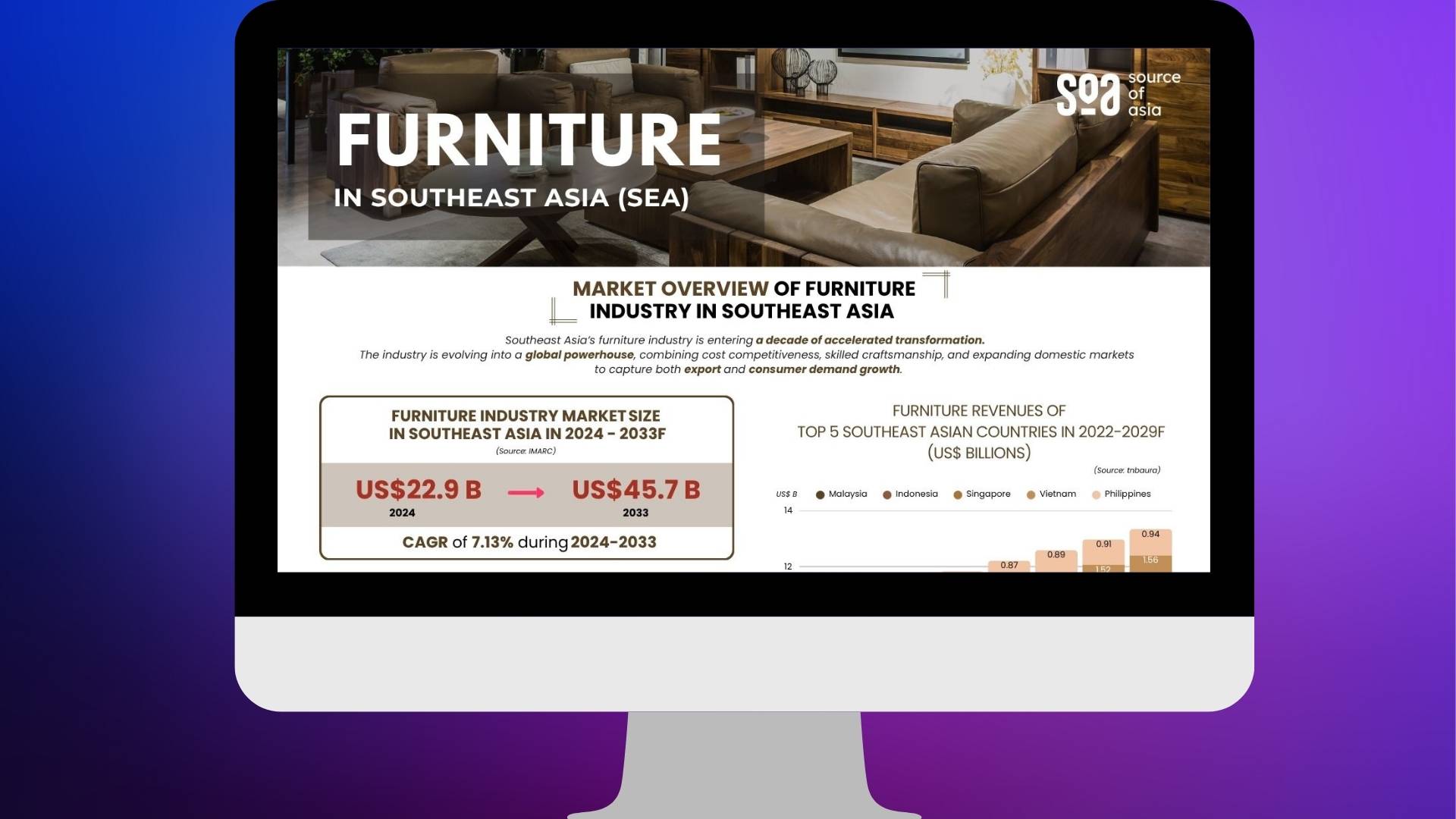Summary
The Southeast Asia furniture industry continues to strengthen its global position as one of the most dynamic and competitive manufacturing clusters. Supported by abundant natural resources, a skilled workforce, and strong export capabilities, the region now plays a central role in the world market furniture ecosystem. According to ASEAN trade statistics and Statista’s market outlook, regional exports consistently surpass US$19 billion (2024), driven by rising demand in the United States, Europe, and Japan.
Moreover, shifting consumer behavior is shaping new furniture trends in Southeast Asia. Households increasingly prefer modern, multifunctional, and space-efficient designs. Sustainability and certified raw materials are now essential for global buyers. As a result, the ASEAN furniture market is evolving rapidly in both supply and demand, and regional producers are adapting to international standards in design, efficiency, and compliance.

Access the FREE Sectorial Note: Southeast Asia Furniture Industry 2025–2026.
Key Highlights from SOA’s Sectorial Note: Southeast Asia Furniture 2026
Our Sectorial Note offers a comprehensive analysis of the Southeast Asia furniture landscape, including market trends, competitive dynamics, and export potential. Key highlights include:
- Export leadership
Vietnam, Malaysia, and Indonesia jointly account for more than 80% of ASEAN’s total furniture exports, covering categories such as wooden indoor furniture, RTA lines, solid wood pieces, and rattan products.
- Growing domestic markets
Rising middle-income populations in Malaysia, Thailand, and the Philippines are increasing demand for mid-range and premium furniture.
- Supply-chain diversification
Global buyers continue to shift production from China toward ASEAN, supporting manufacturing growth in Vietnam, Indonesia, and Malaysia.
- Material evolution
Manufacturers are moving toward engineered wood, FSC-certified timber, bamboo composites, and eco-friendly coatings.
- Emerging product trends
Modular furniture, space-saving solutions, and Scandinavian-inspired designs have strong traction in the Southeast Asian furniture corresponding market needs.
- Digital transformation
E-commerce platforms and cross-border marketplaces are expanding distribution channels, especially for RTA and lifestyle-focused products.
- Country snapshots
Detailed profiles of Vietnam, Indonesia, Malaysia, Thailand, and the Philippines provide comparative insights into cost structures, raw materials, logistics corridors, and workforce strengths.
- Compliance and certification
The report highlights critical certifications, including FSC, PEFC, BSCI, REACH-compliant finishes, and sustainable supply-chain requirements from Western markets.
These insights help sourcing managers, investors, and importers understand production competitiveness and identify opportunities in the ASEAN furniture market.

Consumer Trends of the Furniture Industry in Southeast Asia (Source: Source of Asia)
Furniture Market Definition
Definition
The Southeast Asia furniture market covers the design, production, trade, and retail distribution of furniture across the ASEAN region. According to Statista’s Furniture Market definition, the category includes indoor and outdoor furniture for residential, commercial, and hospitality uses, across both offline and e-commerce channels.
| In-Scope | Out-of-Scope |
Product segments
|
|
Market Structure
A structured breakdown of the market value chain reveals how manufacturers, suppliers, and distributors collaborate to support the region’s expanding furniture ecosystem.
- Raw material and component suppliers.
The region benefits from rubberwood, acacia, teak, bamboo, and rattan. Engineered wood (MDF, HDF, plywood), upholstery foam, textiles, stitching services, hardware, and fittings form essential components of the supply chain. - Manufacturers (OEM / ODM / OBM).
Southeast Asia hosts large-scale export manufacturers alongside craft-based producers. Vietnam and Indonesia dominate OEM and ODM production, while Malaysia specializes in rubberwood products and Thailand in design-driven pieces. - Exporters and trading companies.
These include sourcing offices, global wholesalers, and distributors such as United Furniture Import & Export partners, which connect ASEAN factories with global retail chains. - Retail channels:
- Brick-and-mortar stores
- Home furnishing chains
- Cross-border e-commerce: Shopee, Lazada, Tokopedia, Amazon
- B2B procurement for hotels, offices, and resorts
- End users.
Residential households, hospitality operators, corporate offices, and institutional buyers.
Why Southeast Asia Matters
Southeast Asia holds a strategic position in the global furniture market due to its raw-material advantages, skilled production capabilities, and strong export infrastructure. The region’s manufacturing ecosystems continue to mature, attracting investments from global buyers seeking alternatives to China.

Key National Investment Opportunities Furniture Industry in Southeast Asia (Source: Source of Asia)
Moreover, the region’s competitive labor costs and high adaptability give ASEAN factories an advantage in both mass production and customization. As demand increases in global markets, furniture in Southeast Asia remains well-positioned to serve changing product and design requirements.
Certified materials, sustainable forestry regulations, and tightening global environmental standards also increase the region’s attractiveness. Vietnam and Indonesia are investing in FSC forest expansion and value-added processing, strengthening their roles in the world market furniture supply chain.
E-commerce growth also supports expansion, as ASEAN’s young and digital-oriented consumers drive demand for compact, affordable, and modern designs. Therefore, the Southeast Asia furniture industry will continue reshaping sourcing strategies for major global retailers and importers.

Furniture Industry in Southeast Asia: Pros and Cons (Source: Source of Asia)
FAQs
Vietnam, Malaysia, and Indonesia lead regional exports. Vietnam specializes in engineered wood, RTA, and Scandinavian-style furniture, while Indonesia stands out for solid wood and rattan craftsmanship. Malaysia remains notable for rubberwood-based production and stable export ties with Asia, Europe, and the Middle East.
Customization supports brand differentiation in highly competitive markets. Buyers often request adjustments in dimensions, materials, finishes, and packaging to suit market preferences. Moreover, OEM and ODM flexibility increases contract value and encourages long-term partnerships with global retailers.
Growth comes from export expansion, competitive labor costs, sustainable material access, and the relocation of supply chains into ASEAN. E-commerce adoption, product innovation, and certification compliance also support long-term growth.






